Carbon removal involves the processes of capturing and storing atmospheric CO2, utilizing technologies like direct air capture and afforestation, which are essential for mitigating climate change and achieving global sustainability goals.
Have you ever thought about howcarbon removal technologies like those from Climeworks could shape the future of sustainability? Dive in to discover their impact!
Introduction to Climeworks
Climeworks, a leader in direct air capture technology, is revolutionizing the way we think about carbon removal. Their innovative systems filter CO2 directly from the atmosphere, offering a sustainable solution to the challenges posed by climate change. By harnessing advanced engineering and cutting-edge research, Climeworks is making significant strides in reducing global carbon emissions.
One of the key advantages of Climeworks’ technology is its ability to capture CO2 efficiently and store it for long-term use. This process not only helps combat climate change, but it also opens up numerous opportunities for businesses looking to improve their environmental impact. With the growing emphasis on sustainability, Climeworks is positioning itself as a vital player in the transition towards a greener economy.
Moreover, Climeworks collaborates with various companies and institutions, proving that partnerships can enhance the scalability of carbon removal solutions. The company’s projects highlight how integrated approaches can lead to effective climate action, benefitting both industries and communities alike. As regulations tighten and demand for sustainable practices grows, Climeworks stands at the forefront, ready to assist businesses in meeting new compliance standards.
Overview of Carbon Removal
Carbon removal is an essential process aimed at reducing greenhouse gases in the atmosphere, thereby combating climate change. Various technologies, including direct air capture and bioenergy with carbon capture and storage (BECCS), play crucial roles in this field. These methods help to draw down carbon dioxide and can potentially reverse some impacts of climate change.
Direct air capture systems work by using chemical reactions to filter CO2 from the air. This captured carbon can be stored underground or converted into useable products, contributing to a circular carbon economy. Meanwhile, BECCS leverages biomass energy production, ensuring that the CO2 released during combustion is captured and sequestered.
Another important aspect of carbon removal is the integration of natural processes. Afforestation and reforestation are sustainable methods that increase the number of trees, which absorb CO2 as they grow. These natural solutions are essential for achieving long-term climate goals.
Public awareness and support for carbon removal initiatives are growing. Businesses and governments are increasingly recognizing the importance of these technologies to meet net-zero emissions targets. As a result, investment in carbon removal is expanding, paving the way for innovative solutions that promise a cleaner, more sustainable future.
Importance of Sustainable Technologies
The importance of sustainable technologies cannot be overstated in today’s world, as they play a pivotal role in addressing environmental challenges. These innovations help reduce carbon footprints, conserve resources, and promote a circular economy. By leveraging renewable energy sources like solar, wind, and hydro power, businesses and individuals can significantly decrease their dependence on fossil fuels.
Sustainable technologies also encompass practices such as waste reduction and energy efficiency. For example, smart grid technologies enable better energy distribution and management, optimizing consumption patterns. This not only lowers costs but also minimizes the environmental impact.
Moreover, sustainable technologies drive innovation and economic growth. Companies that prioritize sustainability position themselves favorably in the market, attracting environmentally conscious consumers and investors alike. The shift towards green technology stimulates job creation in sectors focused on sustainability.
In conclusion, the integration of sustainable technologies is imperative for fostering a resilient planet. As we face escalating environmental issues, adopting these technologies can enable societies to thrive without depleting the natural resources essential for future generations.
Trends in Direct Air Capture
Trends in Direct Air Capture (DAC) are rapidly evolving, reflecting the growing urgency to address climate change. This innovative technology focuses on extracting carbon dioxide directly from the atmosphere. Leading companies are continuously refining DAC systems to enhance efficiency and scalability.
One prominent trend is the integration of renewable energy sources into DAC operations. By utilizing solar or wind energy, companies can power their systems more sustainably, reducing operational costs and improving overall environmental impact.
Additionally, collaboration between private and public sectors is gaining momentum. Governments are increasingly providing funding and incentives for DAC projects, fostering innovation and accelerating deployment. This partnership is crucial as it allows for the sharing of research, resources, and expertise.
Moreover, the market for carbon removal credits is expanding. Companies capturing CO2 are able to generate credits that can be sold, incentivizing the adoption of DAC technologies. As awareness and demand for carbon neutrality grow, more industries are looking to invest in such solutions.
Lastly, advancements in material science are leading to better sorbents for capturing CO2. These developments increase the efficiency and reduce costs associated with DAC systems, marking significant progress in sustainable technologies that promise a cleaner future.
Climeworks’ Innovations
Climeworks is at the forefront of carbon removal innovation, pioneering direct air capture technology that significantly addresses climate change. Their unique approach captures carbon dioxide directly from ambient air, allowing the extracted CO2 to be permanently stored underground or repurposed for commercial use.
One of the most notable innovations by Climeworks is its modular system design. This allows for scalable solutions that can be deployed in various locations, adapting to specific environmental and economic contexts. Each unit operates independently, enhancing the flexibility of deployment while ensuring efficiency in carbon capture.
Climeworks also harnesses renewable energy sources to power its systems. By integrating solar and wind energy into their operations, they reduce the overall carbon footprint of their technology. This commitment to sustainability strengthens their position in the green technology space.
Furthermore, Climeworks aims to make carbon removal accessible to everyone by offering subscription services. Individuals and companies can contribute to carbon removal efforts by offsetting their emissions directly through Climeworks’ initiatives. This democratization of carbon capture promotes widespread participation and awareness of sustainability.
Through continuous research and development, Climeworks is setting new standards for carbon removal, making significant contributions toward achieving global climate goals.
Collaboration with Major Corporations
Collaboration with major corporations plays a critical role in advancing the effectiveness of carbon removal technologies. Leading companies are recognising the urgent need for sustainable practices and are actively partnering with innovators like Climeworks to achieve their environmental goals. These partnerships enable businesses to offset their carbon emissions and contribute to global sustainability efforts.
One significant benefit of collaborating with established corporations is access to resources and expertise. Major companies often have the capital and infrastructure necessary to scale carbon removal technologies. This support not only accelerates deployment but also enhances research and development efforts within the field.
Additionally, these alliances help to raise awareness and promote the importance of carbon neutrality. Through joint marketing and educational initiatives, corporations can leverage their influence to inform customers and stakeholders about the role of carbon removal in combating climate change.
For instance, companies in the technology and automotive sectors are incorporating carbon neutrality principles into their operations by investing in direct air capture projects. This alignment not only strengthens their sustainability credentials but also satisfies increasing consumer demand for responsible business practices.
As these collaborations continue to grow, the impact of carbon removal technologies will likely increase, leading to more significant progress in fighting climate change and helping to achieve net-zero emissions goals.
Impact of Carbon Credit Market
The impact of the carbon credit market is significant in the fight against climate change, as it provides a financial incentive for businesses to reduce greenhouse gas emissions. Through this market, companies that exceed regulatory emission targets can sell their excess credits to those struggling to comply. This creates a dual benefit: it encourages innovation in emission reduction technologies while enabling companies to adapt to environmental regulations seamlessly.
Carbon credits are generated from projects that capture and store carbon dioxide or reduce emissions. These projects range from renewable energy installations to reforestation efforts. By investing in these initiatives, companies not only support sustainable practices but also contribute to their corporate social responsibility goals.
The carbon credit market has evolved to become more transparent and accessible, with various platforms facilitating the trading of credits. This accessibility is attracting a broader range of participants, from small businesses to large corporations, promoting widespread engagement in carbon reduction efforts.
Furthermore, as public awareness of climate change grows, companies are increasingly motivated to participate in the carbon credit market. This trend highlights the vital role that carbon credits play in achieving net-zero goals and driving the transition towards a sustainable economy. Overall, the effectiveness of the carbon credit market in incentivizing emission cuts is an essential component of the global strategy to mitigate climate change.
Future of Carbon Removal
The future of carbon removal holds immense potential as technological advancements continue to shape the landscape of environmental sustainability. Innovations in direct air capture, biotechnologies, and enhanced weathering are becoming critical in our efforts to mitigate climate change. As awareness of the need for aggressive carbon reduction grows, so too does the investment in these cutting-edge approaches.
One key area of development is the integration of carbon removal systems with renewable energy sources. This combination not only enhances the efficiency of capturing CO2 but also ensures that the energy used in these processes is sustainable. Companies are focusing on optimizing their technologies to make them more scalable and cost-effective, making carbon removal accessible to a broader range of industries.
Moreover, the rise of carbon markets is incentivizing businesses to invest in removal technologies. As regulations tighten and public pressure mounts for climate action, organizations are increasingly seeing carbon removal not just as an obligation but as an opportunity for innovation and competitive advantage.
Collaboration between governments, NGOs, and the private sector is also pivotal. By creating supportive policies and funding mechanisms, stakeholders can accelerate the deployment of carbon removal technologies. As the landscape evolves, the focus on developing robust, efficient, and economically viable carbon removal solutions will play a crucial role in achieving global climate targets.
Challenges in Carbon Removal
The challenges in carbon removal are significant and multifaceted, impacting the effectiveness and scalability of various technologies. One primary concern is the high cost associated with direct air capture and other carbon removal methods. Developing, deploying, and maintaining these systems requires substantial investment, which can limit access for smaller businesses and emerging markets.
Another challenge is the need for technological advancements. While promising, carbon removal technologies still require ongoing research and development to enhance their efficiency and reduce costs. Achieving breakthroughs in material science and engineering is essential for making these solutions commercially viable.
Additionally, public perception and regulatory frameworks can pose obstacles. Clear and consistent policies are necessary to support carbon removal initiatives. However, fluctuating regulations and public skepticism about the efficacy of carbon capture can slow down the deployment of these technologies.
Moreover, there is a concern about land use and ecological impacts. Solutions like afforestation and bioenergy with carbon capture require large amounts of land, which could compete with agricultural needs or natural habitats. Striking a balance between carbon removal efforts and preserving biodiversity is crucial.
Overall, addressing these challenges is imperative for advancing carbon removal technologies and ensuring they contribute effectively to global climate goals.
Economic Considerations for Businesses
Economic considerations for businesses engaging in carbon removal are critical for long-term sustainability and profitability. As climate consciousness grows, companies face increasing pressure from consumers and regulators to implement sustainable practices. Investing in carbon removal technologies can enhance a company’s reputation, attract environmentally-minded consumers, and ensure compliance with future regulations.
However, the initial costs associated with carbon removal can be daunting. Technologies like direct air capture require significant upfront investment. Businesses must evaluate the return on investment (ROI) over time, including potential savings on carbon taxes and the benefits of being ahead of regulatory requirements.
Furthermore, companies have the opportunity to generate revenue through carbon credits. By capturing and storing carbon, they can sell these credits in carbon markets, creating an additional income stream. This economic model encourages further investment in innovative technologies and projects.
It’s essential for businesses to conduct thorough cost-benefit analyses when considering carbon removal options. This analysis should include both the direct costs and potential savings from improved efficiencies and enhanced brand loyalty. Collaborating with financial experts and sustainability consultants can provide valuable insights into the most effective strategies for integrating carbon removal into a business model.
Canadian Compliance with International Standards
Canadian compliance with international standards is pivotal for ensuring that the country meets its climate targets and maintains its competitive edge in global markets. As businesses increasingly engage in carbon removal initiatives, understanding and adhering to these standards becomes essential.
Canada has committed to several international agreements aimed at reducing greenhouse gas emissions. Compliance with international standards such as the Paris Agreement not only boosts Canada’s credibility on the world stage but also fosters investor confidence in Canadian companies pursuing sustainable practices.
Many organizations are aligning their carbon removal strategies with frameworks established by global authorities, including the International Organization for Standardization (ISO). These frameworks provide guidance on best practices for carbon accounting, reporting, and verification. By following these standards, Canadian businesses can effectively showcase their sustainability efforts and achievements.
Furthermore, regulatory requirements at both federal and provincial levels often mirror these international norms. This alignment encourages a unified approach to carbon management across industries, simplifying compliance efforts for businesses operating domestically and internationally.
By prioritizing compliance with international standards, Canadian businesses not only contribute to the global fight against climate change but also enhance their marketability and resilience in an increasingly eco-conscious economy.
Conclusion and Looking Ahead
As we assess the trajectory of carbon removal technologies, it is clear that the future holds immense potential for innovation and impact. Advancements in areas such as direct air capture, bioengineering, and sustainable practices play a crucial role in combating climate change.
The growing consensus on the importance of sustainability across sectors demonstrates a shift in both public awareness and corporate responsibility. Stakeholders are increasingly prioritizing sustainable practices as they align with global climate goals.
Moreover, ongoing collaboration between governments, businesses, and research institutions is vital. Such partnerships can drive the development of new technologies and make carbon removal more economically viable. With shared resources and expertise, the path toward substantial emission reductions becomes clearer.
Investment in education and public awareness initiatives is also essential, as it cultivates a more informed citizenry that recognizes the significance of carbon removal. Engaging local communities in these discussions can foster wider acceptance and participation in sustainability efforts.
Looking ahead, the continuous evolution of carbon removal strategies will be crucial. To achieve climate targets, we must embrace innovation and remain committed to ambitious sustainability goals. The journey toward a cleaner and more sustainable future requires collective action, determination, and a willingness to adapt and learn.
Looking Ahead: The Future of Carbon Removal
The journey toward effective carbon removal is crucial for tackling climate change. As we move forward, the importance of innovative technologies and community involvement will only grow. By investing in carbon removal solutions, companies can contribute to a sustainable future.
Through collaboration and adherence to international standards, businesses can enhance their impact on the environment. These efforts also present opportunities for economic growth and compliance.
It is clear that the path to a cleaner planet requires shared responsibility. Every action counts, and together, we can make a difference. The future of carbon removal is bright, driven by innovation and commitment to sustainability.
Embracing these technologies and practices not only helps meet climate targets but also fosters a healthier planet for future generations. So, let’s stay proactive and work together toward a sustainable tomorrow.
Frequently Asked Questions
What is carbon removal and why is it important?
Carbon removal refers to the process of capturing and storing carbon dioxide from the atmosphere. It is crucial for combating climate change and reducing greenhouse gas emissions.
How do carbon credits work?
Carbon credits represent a permit allowing the holder to emit a certain amount of carbon dioxide. Companies can buy or sell these credits as part of carbon markets, incentivizing emissions reductions.
What technologies are used for carbon removal?
Technologies such as direct air capture, bioenergy with carbon capture and storage (BECCS), and afforestation are commonly used for capturing and storing carbon dioxide.
How can businesses benefit from investing in carbon removal?
Investing in carbon removal can enhance a company’s reputation, meet regulatory requirements, and provide additional revenue through the sale of carbon credits.
What are the compliance requirements for carbon removal in Canada?
Canadian businesses need to adhere to international standards and local regulations related to carbon emissions, which may involve reporting and verification of carbon capture efforts.
How can individuals participate in carbon removal initiatives?
Individuals can support carbon removal by advocating for sustainable practices, participating in local reforestation projects, or contributing to carbon offset programs.


